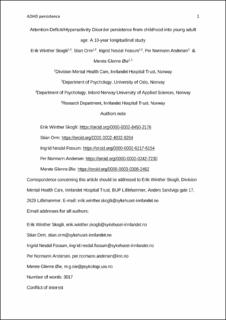| dc.contributor.author | Skogli, Erik Winther | |
| dc.contributor.author | Orm, Stian | |
| dc.contributor.author | Fossum, Ingrid Nesdal | |
| dc.contributor.author | Andersen, Per Normann | |
| dc.contributor.author | Øie, Merete Glenne | |
| dc.date.accessioned | 2023-05-10T11:38:11Z | |
| dc.date.available | 2023-05-10T11:38:11Z | |
| dc.date.created | 2022-09-08T21:25:12Z | |
| dc.date.issued | 2022 | |
| dc.identifier.citation | Cogn Neuropsychiatry. 2022 Nov;27(6):447-457. | en_US |
| dc.identifier.issn | 1354-6805 | |
| dc.identifier.uri | https://hdl.handle.net/11250/3067477 | |
| dc.description.abstract | Problems with executive function (EF) are considered a hallmark of Attention-Deficit/Hyperactivity Disorder (ADHD) and Autism Spectrum Disorder (ASD). However, little is known about the developmental pathway of everyday EF in these two groups, and whether the two groups follow a similar or different developmental course. In this longitudinal study, children and adolescents with ADHD (n = 84, Mage = 11.6, SD = 2.0), ASD (n = 38, Mage = 12.0, SD = 2.3), and typically developing children (TDC; n = 50, Mage = 11.6, SD = 2.0) were clinically diagnosed and assessed with parent-ratings of everyday EF at baseline and at two-year followup (97% retention). Results showed that both individuals with ADHD and individuals with ASD displayed elevated levels of everyday EF problems relative to the TDC at baseline (Hedges g = 1.99 to 2.99). Over the two-year period, everyday EF improved in individuals with ADHD relative to the TDC, whereas individuals with ASD displayed no improvement relative to the TDC. At two-year followup, individuals with ADHD and individuals with ASD continued to display elevated levels of everyday EF problems relative to the TDC (Hedges g = 1.61 to 3.19). | en_US |
| dc.language.iso | eng | en_US |
| dc.publisher | Informa UK Limited | en_US |
| dc.rights | Attribution-NonCommercial-NoDerivatives 4.0 Internasjonal | * |
| dc.rights.uri | http://creativecommons.org/licenses/by-nc-nd/4.0/deed.no | * |
| dc.subject | Attention-deficit/hyperactivity disorder; | en_US |
| dc.subject | European; | en_US |
| dc.subject | adults; | en_US |
| dc.subject | persistence. | en_US |
| dc.title | Attention-deficit/hyperactivity disorder persistence from childhood into young adult age: a 10-year longitudinal study | en_US |
| dc.title.alternative | Attention-deficit/hyperactivity disorder persistence from childhood into young adult age: a 10-year longitudinal study | en_US |
| dc.type | Peer reviewed | en_US |
| dc.type | Journal article | en_US |
| dc.description.version | submittedVersion | en_US |
| dc.source.volume | 27 | en_US |
| dc.source.journal | Cognitive Neuropsychiatry | en_US |
| dc.source.issue | 6 | en_US |
| dc.identifier.doi | 10.1080/13546805.2022.2123735 | |
| dc.identifier.cristin | 2050079 | |
| dc.relation.project | Sykehuset Innlandet HF: grant numbers: 150610, 150624, and 150648 | en_US |
| cristin.ispublished | true | |
| cristin.fulltext | preprint | |
| cristin.fulltext | preprint | |
| cristin.qualitycode | 1 | |

